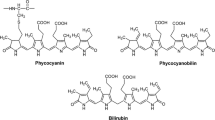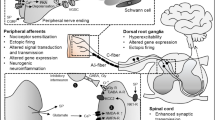Abstract
Aims
Diabetic peripheral neuropathy (DPN) is one of the most important complications of diabetes with a poor prognosis. Saikosaponin d (SSD) is a triterpenoid saponin isolated from Radix Bupleuri that has multiple pharmacological activities. However, whether SSD affects DPN is unclarified.
Methods
Sprague Dawley rats were treated with streptozotocin (STZ) and high-fat diet (HFD) to induce DPN, in the presence or absence of SSD, with or without transfection of lentivirus vectors carrying siRNA targeting aquaporin 1 (si-AQP1). The body weight, plasma glucose levels, mechanical and thermal hyperalgesia, and nerve conductive velocity (NCV) of rats were measured. Hematoxylin–Eosin staining was used for histopathological observation of sciatic nerves. RT-qPCR and western blotting were utilized for measuring expression levels of AQP1 and ras homolog family member A/Rho-associated protein kinase (RhoA/ROCK) signaling pathway-related markers in dorsal root ganglion (DRG) of rats.
Results
SSD increased the body weight, decreased plasma glucose levels, attenuated mechanical and thermal hyperalgesia, enhanced NCV and reduced proinflammatory cytokine levels in DPN rats. AQP1 displayed a high level in DPN rats and SSD treatment repressed the expression of AQP1. SSD enhanced the protective effect of AQP1 knockdown on the pathological changes of DPN. AQP1 depletion suppressed the activation of RhoA/ROCK signaling pathway in DPN rats.
Conclusion
SSD alleviates STZ/HFD-induced DPN in rats by inhibiting the AQP1/RhoA/ROCK signaling pathway.




Similar content being viewed by others
Abbreviations
- DPN:
-
Diabetic peripheral neuropathy
- SSD:
-
Saikosaponin d
- STZ:
-
Streptozotocin
- HFD:
-
High-fat diet
- DRG:
-
Dorsal root ganglion
- siRNA:
-
Small interference RNA
- AQP1:
-
Aquaporin 1
- RhoA:
-
Ras homolog family member A
- ROCK:
-
Rho-associated protein kinase
- LIMK:
-
LIM-domain kinase 1
- TNF-α:
-
Tumor necrosis factor alpha
- IL-1β:
-
Interleukin 1beta
- IL-6:
-
Interleukin 6
- PWL:
-
Paw withdrawal threshold
- NCV:
-
Nerve conductive velocity
- MNCV:
-
Motor NCV
- SNCV:
-
Sensory NCV
- ELISA:
-
Enzyme-linked immunosorbent assay
- RT-qPCR:
-
Real-time quantitative polymerase chain reaction
- ANOVA:
-
Analysis of variance
References
Pop-Busui R, Boulton AJ, Feldman EL et al (2017) Diabetic neuropathy: a position statement by the american diabetes association. Diabetes Care 40(1):136–154
Xu C, Hou B, He P et al (2020) Neuroprotective effect of salvianolic acid A against diabetic peripheral neuropathy through modulation of Nrf2. Oxid Med Cell Longev 2020:6431459
Castelli G, Desai KM, Cantone RE (2020) Peripheral neuropathy: evaluation and differential diagnosis. Am Fam Physician 102(12):732–739
Addepalli V, Suryavanshi SV (2018) Catechin attenuates diabetic autonomic neuropathy in streptozotocin induced diabetic rats. Biomed Pharmacother 108:1517–1523
Yang K, Wang Y, Li YW et al (2022) Progress in the treatment of diabetic peripheral neuropathy. Biomed Pharmacother 148:112717
Liu J, Dong B, Yang L et al (2021) Xuefu Zhuyu decoction for nonalcoholic fatty liver disease: a protocol for systematic review and meta-analysis. Medicine (Baltimore) 100(19):e25358
Liu X, Zheng X, Du G et al (2019) Brain metabonomics study of the antidepressant-like effect of Xiaoyaosan on the CUMS-depression rats by (1)H NMR analysis. J Ethnopharmacol 235:141–154
Ashour ML, Wink M (2011) Genus Bupleurum: a review of its phytochemistry, pharmacology and modes of action. J Pharm Pharmacol 63(3):305–321
Yuan B, Yang R, Ma Y et al (2017) A systematic review of the active saikosaponins and extracts isolated from Radix Bupleuri and their applications. Pharm Biol 55(1):620–635
Lin X, Wu S, Wang Q et al (2016) Saikosaponin-D reduces H(2)O(2)-induced PC12 cell apoptosis by removing ROS and blocking MAPK-dependent oxidative damage. Cell Mol Neurobiol 36(8):1365–1375
Li ZY, Jiang YM, Liu YM et al (2014) Saikosaponin D acts against corticosterone-induced apoptosis via regulation of mitochondrial GR translocation and a GR-dependent pathway. Prog Neuropsychopharmacol Biol Psychiatry 53:80–89
Zhao L, Zhang H, Bao J et al (2015) Saikosaponin-d protects renal tubular epithelial cell against high glucose induced injury through modulation of SIRT3. Int J Clin Exp Med 8(4):6472–6481
Segura-Anaya E, Martínez-Gómez A, Dent MA (2015) Localization of aquaporin 1 water channel in the Schmidt–Lanterman incisures and the paranodal regions of the rat sciatic nerve. Neuroscience 285:119–127
Gao H, He C, Fang X et al (2006) Localization of aquaporin-1 water channel in glial cells of the human peripheral nervous system. Glia 53(7):783–787
Zhang H, Verkman AS (2010) Aquaporin-1 tunes pain perception by interaction with Na(v)1.8 Na+ channels in dorsal root ganglion neurons. J Biol Chem 285(8):5896–5906
Jiang Y (2009) Aquaporin-1 activity of plasma membrane affects HT20 colon cancer cell migration. IUBMB Life 61(10):1001–1009
Sun Z, Wu X, Li W et al (2016) RhoA/rock signaling mediates peroxynitrite-induced functional impairment of Rat coronary vessels. BMC Cardiovasc Disord 16(1):193
Yan Q, Wang X, Zha M et al (2018) The RhoA/ROCK signaling pathway affects the development of diabetic nephropathy resulting from the epithelial to mesenchymal transition. Int J Clin Exp Pathol 11(9):4296–4304
Zhu L, Wang W, Xie TH et al (2020) TGR5 receptor activation attenuates diabetic retinopathy through suppression of RhoA/ROCK signaling. Faseb j 34(3):4189–4203
Xu L, Su J, Guo L et al (2019) Modulation of LPA1 receptor-mediated neuronal apoptosis by Saikosaponin-d: A target involved in depression. Neuropharmacology 155:150–161
Shi X, Chen Y, Nadeem L et al (2013) Beneficial effect of TNF-α inhibition on diabetic peripheral neuropathy. J Neuroinflammation 10:69
Yu MX, Lei B, Song X et al (2021) Compound XiongShao Capsule ameliorates streptozotocin-induced diabetic peripheral neuropathy in rats via inhibiting apoptosis, oxidative—nitrosative stress and advanced glycation end products. J Ethnopharmacol 268:113560
Wang M, Xie M, Yu S et al (2021) Lipin1 alleviates autophagy disorder in sciatic nerve and improves diabetic peripheral neuropathy. Mol Neurobiol 58(11):6049–6061
Dang SS, Wang BF, Cheng YA et al (2007) Inhibitory effects of saikosaponin-d on CCl4-induced hepatic fibrogenesis in rats. World J Gastroenterol 13(4):557–563
Lu XL, He SX, Ren MD et al (2012) Chemopreventive effect of saikosaponin-d on diethylinitrosamine-induced hepatocarcinogenesis: involvement of CCAAT/enhancer binding protein β and cyclooxygenase-2. Mol Med Rep 5(3):637–644
Impellizzeri D, Peritore AF, Cordaro M et al (2019) The neuroprotective effects of micronized PEA (PEA-m) formulation on diabetic peripheral neuropathy in mice. FASEB J 33(10):11364–11380
Ding Y, Dai X, Zhang Z et al (2014) Proanthocyanidins protect against early diabetic peripheral neuropathy by modulating endoplasmic reticulum stress. J Nutr Biochem 25(7):765–772
Barrell K, Smith AG (2019) Peripheral neuropathy. Med Clin North Am 103(2):383–397
Hagen KM, Ousman SS (2021) Aging and the immune response in diabetic peripheral neuropathy. J Neuroimmunol 355:577574
Xie J, Song W, Liang X et al (2020) Jinmaitong ameliorates diabetic peripheral neuropathy in streptozotocin-induced diabetic rats by modulating gut microbiota and neuregulin 1. Aging (Albany NY) 12(17):17436–17458
Jiang J, Meng Y, Hu S et al (2020) Saikosaponin D: a potential therapeutic drug for osteoarthritis. J Tissue Eng Regen Med 14(8):1175–1184
Zhou P, Shi W, He XY et al (2021) Saikosaponin D: review on the antitumour effects, toxicity and pharmacokinetics. Pharm Biol 59(1):1480–1489
Chen Y, Que R, Zhang N et al (2021) Saikosaponin-d alleviates hepatic fibrosis through regulating GPER1/autophagy signaling. Mol Biol Rep 48(12):7853–7863
Su J, Pan YW, Wang SQ et al (2020) Saikosaponin-d attenuated lipopolysaccharide-induced depressive-like behaviors via inhibiting microglia activation and neuroinflammation. Int Immunopharmacol 80:106181
Wang Z, Li J, Wu W et al (2021) Saikosaponin D rescues deficits in sexual behavior and ameliorates neurological dysfunction in mice exposed to chronic mild stress. Front Pharmacol 12:625074
Canta A, Chiorazzi A, Meregalli C et al (2009) Continuous buprenorphine delivery effect in streptozotocine-induced painful diabetic neuropathy in rats. J Pain 10(9):961–968
Feldman EL, Nave KA, Jensen TS et al (2017) New horizons in diabetic neuropathy: mechanisms, bioenergetics, and pain. Neuron 93(6):1296–1313
Chen M, Li Y, Xiao L et al (2020) AQP1 modulates tendon stem/progenitor cells senescence during tendon aging. Cell Death Dis 11(3):193
Hua Y, Ying X, Qian Y et al (2019) Physiological and pathological impact of AQP1 knockout in mice. Biosci Rep 39(5)
Oshio K, Watanabe H, Yan D et al (2006) Impaired pain sensation in mice lacking Aquaporin-1 water channels. Biochem Biophys Res Commun 341(4):1022–1028
Wu Z, Li S, Liu J et al (2015) RNAi-mediated silencing of AQP1 expression inhibited the proliferation, invasion and tumorigenesis of osteosarcoma cells. Cancer Biol Ther 16(9):1332–1340
Zhou H, Li YJ (2010) RhoA/Rho kinase: a novel therapeutic target in diabetic complications. Chin Med J (Engl) 123(17):2461–2466
Martín-Cámara O, Cores A, Lopez-Alvarado P et al (2021) Emerging targets in drug discovery against neurodegenerative diseases: Control of synapsis disfunction by the RhoA/ROCK pathway. Eur J Med Chem 225:113742
Acknowledgements
Not applicable.
Funding
The work was supported by Hubei Provincial Health and Health Commission Traditional Chinese Medicine Research Project, Young Talent Project (Approval Number: ZY2021Q037).
Author information
Authors and Affiliations
Corresponding author
Ethics declarations
Conflict of interest
The authors declare that they have no conflict of interest.
Ethical statement
All animal experiments were conducted following the National Institutes of Health (NIH) Guide for the Care and Use of Laboratory Animals and approved by the Animal Ethics Committee of Hubei Provincial Hospital of Traditional Chinese Medicine, Hubei Province Academy of Traditional Chinese Medicine.
Informed consent
Informed consent is not required in this study.
Additional information
Managed by Massimo Porta.
Publisher's Note
Springer Nature remains neutral with regard to jurisdictional claims in published maps and institutional affiliations.
Rights and permissions
Springer Nature or its licensor (e.g. a society or other partner) holds exclusive rights to this article under a publishing agreement with the author(s) or other rightsholder(s); author self-archiving of the accepted manuscript version of this article is solely governed by the terms of such publishing agreement and applicable law.
About this article
Cite this article
Xiang, Q., Liu, Y. & Chen, L. Saikosaponin d (SSD) alleviates diabetic peripheral neuropathy by regulating the AQP1/RhoA/ROCK signaling in streptozotocin-induced diabetic rats. Acta Diabetol 60, 805–815 (2023). https://doi.org/10.1007/s00592-023-02060-9
Received:
Accepted:
Published:
Issue Date:
DOI: https://doi.org/10.1007/s00592-023-02060-9




